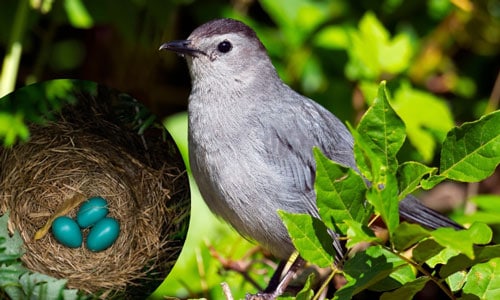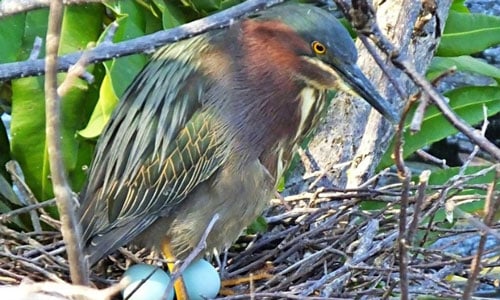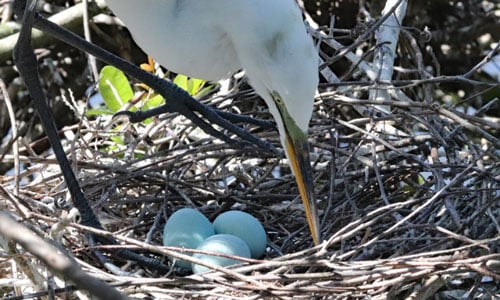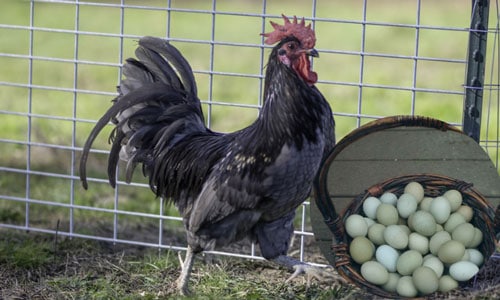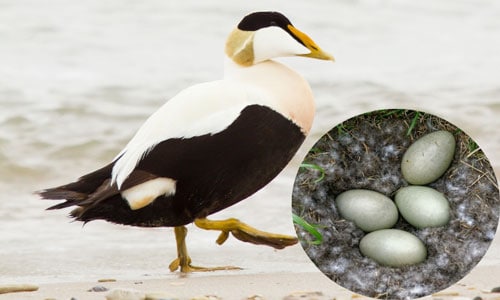Most of us have read or heard about Dr. Seuss’s children’s book, Green Eggs and Ham. However, did you know that you can actually have green eggs?
If you want to try them like Sam-I-Am, you must first learn what bird lays green eggs.
Birds that lay green eggs include Isbar chickens, whimbrels, northern mockingbirds, gray catbirds, and the American crow.
Why are their eggs green, and where can you find these species? Read on to learn some bird egg identification!
Table of Contents
- Types of Birds That Lay Green Eggs
- 1. Gray Catbird (Dumetella Carolinensis)
- 2. Southern Cassowary (Casuarius Casuarius)
- 3. Northern Mockingbird (Mimus Polyglottos)
- 4. Green Heron (Butorides Virescens)
- 5. Little Egret (Egretta Garzetta)
- 6. Isbar Chickens (Gallus Domesticus)
- 7. Common Eider (Somateria Mollissima)
- 8. Eurasian Whimbrel (Numenius Phaeopus)
- 9. American Crow (Corvus Brachyrhynchos)
- Conclusion
Types of Birds That Lay Green Eggs
Generally, how light or dark an egg’s color is affects how much heat and light reaches the chick inside.
Therefore, green eggs in nature don’t often have much to do with camouflage. Rather, they have to do with keeping the chick comfortable inside.
Kindly make sure you credit any information taken from other sources for our editor to fact-check them thoroughly. Here are nine bird species that lay green eggs in various shades.
1. Gray Catbird (Dumetella Carolinensis)
Gray catbirds are very vocal birds named for their cat-like calls and love for thickets and shrubs (Dumetella comes from the Latin dūmus, which means “thorny thicket”). They primarily eat insects and berries.
These birds can be found in most US states during spring and summer before they migrate to southern States and Central America for winter. Several states along the east coast are home to these songbirds year-round.
Grey catbirds produce small green eggs, actually beautiful turquoise green, typically in clutches of 3-5. However, they can lay as few as two or as many as 6 per brood, with two broods per year. Each egg is about an inch long and half an inch wide.
The green-grey catbird eggs are incubated by their mother for 12-13 days. Chicks leave their nest 10-11 days after hatching.
2. Southern Cassowary (Casuarius Casuarius)
Southern cassowaries are large, flightless black birds from Australia and Papua New Guinea.
Related to emus and ostriches, these birds have black bodies, long necks, blue faces, two red wattles, and tall, brown, bony crests (“casques”) on their heads. Their appearance is a clue that they are descendants of ancient dinosaurs!
Females lay three to six eggs, five inches long, per brood. The males incubate them for fifty days.
Though chicks can walk hours after hatching, they remain with their parents for nine months before leaving in search of their mates.
Aside from heat protection, this bird’s egg color is connected to its habitat. The dark green eggs blend in with their natural rainforest habitat and stay safe.
Southern cassowaries primarily eat fruits and small animals when available.
3. Northern Mockingbird (Mimus Polyglottos)
Northern mockingbirds are prevalent across North America but are more populous in the southern states during winter. They are the state bird of five states: Arkansas, Florida, Mississippi, Tennessee, and Texas!
These birds lay eggs in clutches of 3-4, with each egg roughly one inch long and 0.7 inches wide.
Their light green speckled eggs can sometimes appear more bluish-grey. The exact eggshell color depends on numerous factors, including genetics, age, diet, and overall health of the female.
After an incubation of 11-14 days by the female, the chicks need about 10-15 days of care before flying off on their own.
Northern mockingbirds are songbirds found anywhere with trees, from forests to parks to backyards, where they can eat seeds, fruit, and insects.
4. Green Heron (Butorides Virescens)
Green herons are found in North and Central America. They have glossy feathers in maroon, dark green, grey, and black shades.
Like all herons, these birds are often found near the water, particularly in wetlands, lakes, rivers, and swamps. Their diet primarily consists of fish and other water-dwelling insects.
Female green herons lay pale blue-green eggs in clutches of 3-5, with 1-2 broods a year. The eggs are incubated by both parents in turns for a total of 21 days.
While the young can fly by the time they are three weeks old, they typically remain with their parents for at least a full month before leaving on their own.
5. Little Egret (Egretta Garzetta)
Also hailing from the heron family, little egrets are named for their smaller-than-average size. While great blue herons have body lengths of up to 54 inches, little egrets are typically half that, with an average body size of 24 inches.
The all-white egrets live in the wetlands of Europe, Africa, Australia, and Asia. Occasionally, they are spotted along the eastern US coast and northern South America. They typically eat fish but will also eat small reptiles, amphibians, mammals, and insects in their habitat.
Female little egrets lay 3-5 eggs per brood, which they incubate with the father for 21-25 days. After hatching from their oval-shaped little green eggs, chicks stay with their parents for 40-45 days before leaving the nest.
6. Isbar Chickens (Gallus Domesticus)
While chickens are typically associated with white or brown eggs, certain species, such as the Isbar chicken, lay green eggs!
Isbar chickens were created by Martin Silverudd in the 1980s in Sweden, hence their other name, “Silverudd Blue.” The bird is a crossbreed of New Hampshire and Rhode Island Red chickens. Most Isbars are primarily black, though some have bluish or coppery feathers.
Typically, Isbar hens lay about 200 light green eggs a year, making them great egg producers. However, this chicken isn’t often eaten for its meat.
Isbars are easy to raise and maintain since they can forage on their own. They prefer colder climates, making them ideal for those living up north.
Other chicken breeds that lay green eggs include Favaucanas, Ice Cream Bar chickens, Easter Eggers, and Olive Eggers.
7. Common Eider (Somateria Mollissima)
Common eiders are arctic ducks found along the northern coasts of Europe and North America. They love mussels but will eat almost any crustacean or mollusk they can catch.
While the males are black-and-white with bright yellow bills, females have all-brown bodies.
Females lay 3-5 eggs in nests lined with their feathers. After 24-25 days of incubation solely by the mother, the chicks hatch from their eggs and promptly head to the water to swim. The little ducks will fly after they turn two months old, at 65-75 days of age.
Eiders are social birds. While nesting, females come together to create “duck daycares” called creches. A creche can sometimes have up to hundreds of ducklings under the watchful eye of several adults who take turns holding onto the responsibility.
8. Eurasian Whimbrel (Numenius Phaeopus)
The Eurasian whimbrel is also known as the common or white-rumped whimbrel.
Though more prevalent in Europe, Africa, Asia, and Australia, the bird can also occasionally be seen along the coasts of North America.
This water bird lives in open areas with water, such as mudflats, beaches, and marshes. They eat a varied diet of crabs, fish, berries, and insects.
Female whimbrels lay 3-4 olive green eggs, typically spotted with brown marks. The eggs are 2-2.5 inches long with an average width of 1.5 inches.
Both parents take turns incubating the egg for 24-28 days.
Unlike other chicks that rely on their parents for food after hatching, whimbrel chicks learn to feed themselves within the first two hours of life.
They typically begin flying when they turn 5-6 weeks old.
9. American Crow (Corvus Brachyrhynchos)
American crows are common throughout North America. They are all-black birds, from their feathers to the tips of their beaks and claws.
These highly adaptive crows are found in nearly all habitats except the tundra. Though known as eaters of carrion, crows also eat many other things, including fruits, nuts, seeds, fish, eggs, and small mammals.
American crows lay 4-6 eggs per brood. Each egg is 1.5-2 inches long with a width of about an inch. The eggs are bluish-green with brown blotches.
Incubation takes 16-18 days and is typically done by only the female. The chicks leave the nest about a month after hatching.
Conclusion
What bird lays green eggs? Those that live in specific environments that call for it—or those that have been crossbred and develop the genetics for it.
Ultimately, the egg yolk inside stays the same, regardless if the bird has green egg shells or another color. As the saying goes, “Don’t judge an egg by its color.”
After all, we only eat white and brown eggs because they are more common and cheaper.
If you truly want to, you can definitely have those green eggs.

George and I became friends after a birdwatching trip with our new group. And we have been enjoying every adventure together. When he told me the idea of establishing a site that shares our experiences and fun, I immediately agreed. After trials and errors, here we have Thayerbirding.




